
Nonprofit-Dedicated OCIO
Providing nonprofits with customized investment strategies and specialized expertise, a nonprofit-dedicated OCIO can ensure mission-aligned financial stewardship. By concentrating on the nonprofit...

Key Takeaways from Forum 2025
Commonfund Forum 2025, held in Orlando, brought together registrants from some 370 institutions with more than $800 billion in endowed assets representing 42 states and five foreign countries in a...

Forum 2025 Key Statistics [Infographic]
Commonfund recently hosted its 27th annual Commonfund Forum, March 9th-11th, in Orlando, Florida. The event brought together institutional investors to engage in a three-day conference to explore...

U.S. Trade Deficit Reaches Record High Amid Global Trade Shifts
As of September 2024, the U.S. trade deficit stands at $84.4 billion, marking the highest level since the onset of the Russia-Ukraine war in 2022. During that period in the conflict, the deficit...

Celebrating Native American Heritage Month: A Resource Guide
Commonfund, in conjunction with our Native American Heritage Month subcommittee, has created a resource guide to help all of us celebrate the contributions of Native Americans and Indigenous people...

The Pivot Heard Around the World
A U.S. Federal Reserve (“Fed”) pivot is felt throughout global markets, affecting economies worldwide.

Celebrating Hispanic Heritage Month: A Resource Guide
National Hispanic Heritage Month (Spanish: Mes Nacional de la Herencia Hispana) is an annual celebration commemorating the history, contributions, and culture of U.S. Latino and Hispanic communities.

How Long Can the Yen Carry Trade Carry On?
Since Japan's economic crash in the 1990s, the Bank of Japan (BOJ) has maintained extremely low interest rates to combat deflation. For nearly a decade, Japan's benchmark rate has been negative,...

Celebrating Pride Month: A Resource Guide
Pride month is the promotion of the self-affirmation, dignity, equality and increased visibility of lesbian, gay, bisexual, transgender, intersex and asexual people (LGBTQIA+) as a social group....

Celebrating Asian American and Pacific Islander Heritage Month
Asian American and Pacific Islander Heritage Month got its start as a congressional bill, inspired by Black History Month and Hispanic Heritage Month, with the mission of bringing attention to the...

What's Driving Surprisingly Low Volatility in Energy Markets?
In the current geopolitical environment, we would have historically expected much more volatility in the energy complex. Oddly, that has not been the case over the last 6 months. In fact, crude oil...

The Economic Equation: Solving for the Unknowns
2 + 2 = ? In the world of economics—a lot of variables may mess with the answer. Two sessions early in the agenda at Commonfund Forum 2024 brought into focus the range of scenarios in play for...

China Continues to Drag Emerging Markets into 2024
2023 marked the third year of drawdowns for the Chinese equity markets, reflecting a country still trying to emerge from the pandemic period. A combination of factors continued to hamper the once...

Celebrating Black History Month: A Resource Guide
Black History Month is an annual celebration of achievements by African Americans and a time for recognizing their central role in U.S. history. Also known as African American History Month, the...

Bad News is “Good” for Markets to Close 2023
As we inch closer to 2024, domestic markets have been largely driven by shifts in sentiment surrounding the macroeconomic environment, leading many to question the relationship between “bad news” and...

Yield Curve Dynamics in Focus to Close 2023
After a relatively tame summer, significant cross-asset volatility has returned with both the MOVE and VIX indices increasing by 37 and 48 percent respectively, after approaching the lows for 2023 in...

Lagarde Offers Little Comfort Amidst All Time High ECB Rates
Last Thursday marked the tenth hike of the European Central Bank (“ECB”) deposit rate.

Global Currency Returns Diverge
A year ago, the dollar was approaching multi-decade highs as global currencies coped with the most aggressive FOMC hiking cycle of the last forty years.

Markets Signal Higher for Longer Interest Rates
Market sentiment on bonds continues to trend lower, leaving the overall open interest in short-dated U.S. Treasury futures net short at an unprecedented level. There is the potential that these short...

Midyear Rally or Multiple Expansion?
The long-awaited decline in earnings growth appears to be upon us nearly halfway through 2023. Expectations for S&P 500 year-end earnings per share (EPS) growth range from flat to a tepid 1 percent.

Unemployment Appears Poised to Increase
Other than the impending recession, one of 2023’s most anticipated economic changes has been a labor market slowdown, with both economists and investors expecting a deceleration in economic activity...
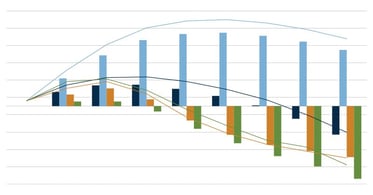
Bond Market Expectations Take a Wild Ride
In today’s environment, commentary can seemingly become stale in periods as short as hours, let alone days. Just last month, we wrote how despite tightening lending conditions from banks, other...

Celebrating Women's History Month
Women's History Month 2023 | Celebrating Women Who Tell Our Stories Women’s History Month is an annual declared month that highlights the contributions of women to events in history and contemporary...

Forum 2023 Key Statistics [Infographic]
Commonfund recently hosted its 25th annual Commonfund Forum, February 13-15th, in Boca Raton, Florida. The event brought together institutional investors to engage in a three-day conference to...
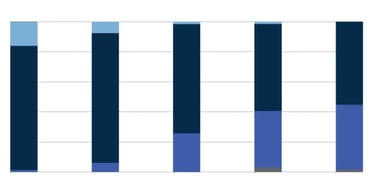
Rate Hikes are Impacting Bank Lending Behavior
As investors grapple with adjusting to 450 basis points of rate hikes (and likely more in sight), the debate on just how quickly monetary policy will transmit through the real economy has returned to...
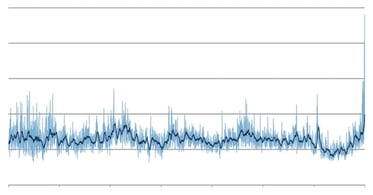
Markets Rally to Close 2022, but Sentiment Remains Dismal
Strong Fourth Quarter for Global Markets Following three quarters of bleak performance, global markets staged a rally to close what was a tumultuous 2022.

Supply Chains Take a Wild Ride
In 2021, the word was transitory. This described the expectations of Fed officials and many other prognosticators that elevated inflation would quickly return to the pre-COVID level of at or around 2...

Diversity and Inclusion: Ways to Make a Change
Throughout American history, discrimination has not only been ever present, but era-defining. In each of those eras, however, there have been pivotal moments where activists organized, made...
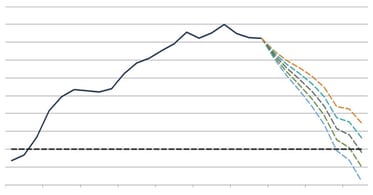
Chart of the Month | The Shape of Inflation
The Consumer Price Index continues to surprise central bankers, commentators, and market participants alike. The latest headline reading of 8.2 percent, which reflects year-over-year price increases...
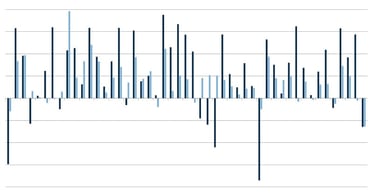
The “Divorcification” of Stocks and Bonds
It has been a difficult start for traditional portfolios of stocks and bonds in 2022 as the usual diversification benefits of these asset classes have failed to materialize. As high inflation remains...

In Remembrance: Laurance (Laurie) R. Hoagland, Jr.
The Commonfund community was saddened to learn of the recent passing of Laurie Hoagland. Laurie served as a member of the Commonfund Board from 2000-2012 and was Board Chair from 2010-2012.
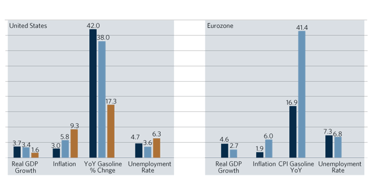
Are Stagflation Fears Justified?
Stagflation fears are growing among investors as inflation recently accelerated at the same time 2022 GDP growth projections declined due to weaker consumer sentiment and increased risk aversion. A...

Hitting the Hot Buttons: Investing for the Next 2 to 4 Years
Commonfund Forum 2022 featured an expert panel representing diverse perspectives to probe beyond the headline-grabbing news that has been driving financial markets in recent months. The accompanying...
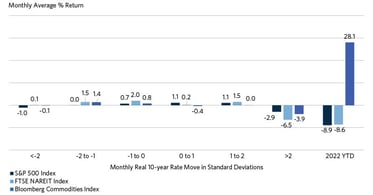
Is this Time Different? Risk Assets and Real Rate Moves
February ended in the same fashion as January, with elevated volatility across a wide spectrum of asset classes. Equities, fixed income, currencies, commodities, and cryptocurrencies all swung...
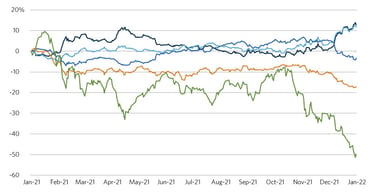
Tech Stocks Lead the Market Decline in Early 2022
2022 began with one of the worst market performance periods since 2009. While the tech-heavy NASDAQ index looks to finish January with a loss of around 10 percent, value equities will likely record...

Celebrating and Honoring Rev. Dr. Martin Luther King Jr.
On January 17, 2022, the nation will celebrate the legacy and leadership of Rev. Dr. Martin Luther King Jr. Dr. King—a graduate of Morehouse College—was a Baptist minister, a peace seeking civil...
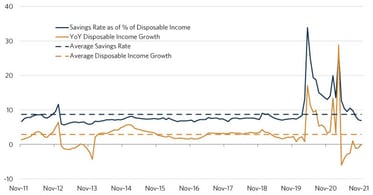
Consumer Savings and Disposable Income Under Pressure
As 2021 comes to an end, we enter 2022 with a good dose of uncertainty in the markets as the Fed begins to reduce and ultimately removes its accommodative policy which has been in place since the...

In Remembrance: Verne O. Sedlacek
A Gentle Giant The Commonfund community was shocked and saddened this week by the news of the sudden passing of our former President and CEO, Verne Sedlacek at the age of 67.
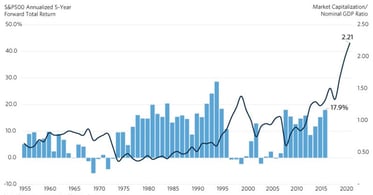
Sky High Valuations Could Spell Weaker Forward Returns
When we look for potential roadblocks that could spoil the breakneck pace of capital markets, the first risk that comes to mind is record-high valuations. While inflation risks have become more...

Chart of the Month | Fed Remains Patient on Rate Hikes Despite Market Expectations For A More Aggressive Move
In its latest meeting on November 3rd, the Fed announced its decision to begin scaling back its historic bond purchasing program, marking the beginning of the end of the program that was aimed at...
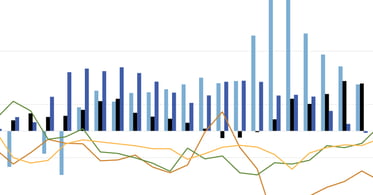
Chart of the Month | Are We on the Verge of a Global Energy Crisis?
It is hard to imagine that in the short span of less than 18 months, energy markets went from a state of overabundance to one of severe shortages and skyrocketing prices. In April 2020, Brent oil...
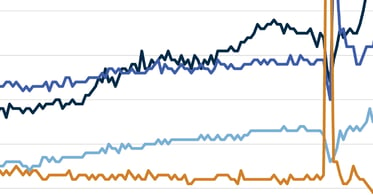
Chart of the Month | The Confusing State of the Labor Market
The U.S. labor market continues to recover from one of the worst declines in employment since the 1930s. In the early days of the pandemic last April, demand for labor plummeted and the unemployment...
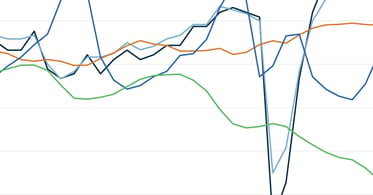
Chart of the Month | Home Prices Are Up 32 Percent In Five Years – And Still Climbing
Housing demand appears to be slowing down in the first half of 2021, yet home prices have continued to climb at an accelerated pace. This month’s chart highlights the supply and demand factors...

Commonfund Celebrates 50 Years of Service
On July 1st, 1971, The Common Fund for Nonprofit Organizations commenced operations with a $2.8 million grant from the Ford Foundation under the leadership of President George Keane and the Board of...
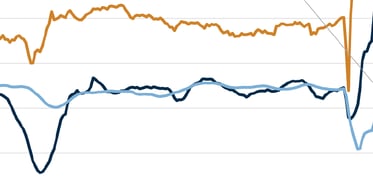
Chart of the Month | Supply Chain Woes as the Pandemic Recedes in the U.S.
Supply chain woes continue to wreak havoc for retailers who are grappling with a strong rebound in consumer spending. Average six-month spending on durable goods, spurred by over $5 trillion in...
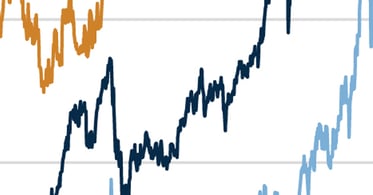
Chart of the Month | Emerging Markets Trail the Pack Despite Rising Demand and Commodities Prices
As growth continues to rebound around the world and investors return to their pre-pandemic way of life, global market performance is beginning to reflect the divergent speed of normalization within...

In Memoriam: George F. Keane
George F. Keane, 91, of 7408 Eaton Court, Sarasota, FL, founder of The Common Fund, and noted philanthropic investment strategist, passed away Thursday, May 20, 2021, peacefully in the Spring Meadows...

Commonfund Trustee, Dr. David A. Thomas, Wins 62nd Annual HBR McKinsey Award
Commonfund's Trustee, Dr. David A. Thomas, wins the 62nd Annual HBR McKinsey Award, for co-authoring the article titled "Getting Serious About Diversity: Enough Already with the Business Case." The...

Chart of the Month | The Surprising Relationship Between Money Supply and Inflation
The potential for rising inflation is becoming a top concern for many investors and consumers. Many believe that inflation is already here as evidenced by price increases in commodities, homes,...

How Your Organization Can Nurture Innovation While Balancing Risk
The theme for Commonfund Forum 2021 was “Transformation.” The objective of the agenda was to deliver timely, useful content on core subjects related to nonprofit endowment and financial management...

From Generosity to Justice | Observations from the President of Ford Foundation
The theme for Commonfund Forum 2021 was “Transformation.” The objective of the agenda was to deliver timely, useful content on core subjects related to nonprofit endowment and financial management...
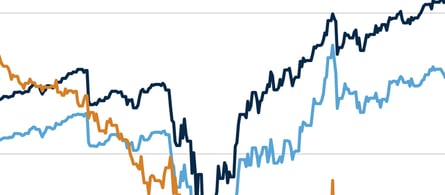
Chart of the Month | The Stock Market Rally May Finally Be Broadening Beyond Tech Names
The trend of improving performance of sectors most sensitive to the strengthening economy remained on track in February 2021. For the most part of 2020, the traditional S&P 500 market-cap-weighted...
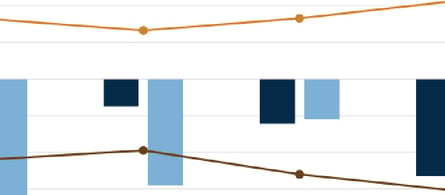
Chart of the Month | Are Bonds Still a Good Hedge for Equity Market Declines?
In the middle of January, the Biden administration announced the details on a new $1.9 trillion stimulus package, including enhanced unemployment benefits, an increase in the minimum wage, and...
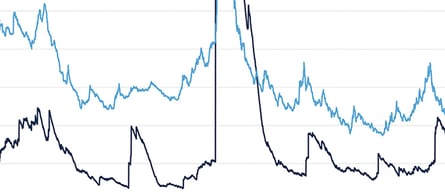
Chart of the Month | Beware of High Yield Bonds
Income-hungry investors continued to push yields on speculative grade bonds to new lows despite the challenging business conditions this year. The yield on the Bloomberg Barclays Corporate High Yield...

Investment Governance | Are You Asking These Three Questions?
In the midst of a global pandemic, many non-profit business models are being challenged which has put significant pressures on staff, governing boards and committees. These pressures on time and...
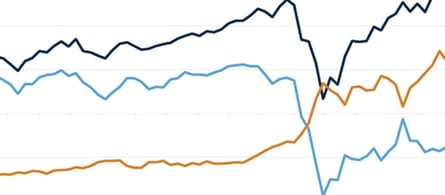
Chart of the Month | Are Value Stocks Finally Going to Make a Run?
The month of November saw a sharp rotation into value equities at the expense of technology and communication services companies, causing investors to wonder whether the long-run dominance of growth...
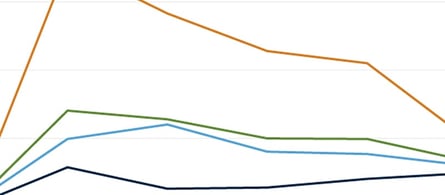
Chart of the Month | Recession Impacts on Employment and Wages
It may come as a surprise to many that average disposable personal incomes have increased by 6.6 percent from February prior to the pandemic through August. This is down from a high of 9.8 percent in...
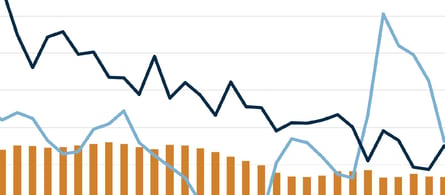
Chart of the Month | Low Rates Make Record Government Debt Manageable – For Now
Few people would have predicted that U.S. equity markets would be higher today than at the start of 2020 if told that a virus would infect over 7.0 million people in the U.S., cause over 200,000...
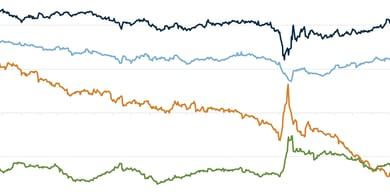
Chart of the Month | Inflation Expectations Surge, Driving Real Interest Rates Down
Chairman Powell’s speech at Jackson Hole during the last week of August confirmed the Fed’s dovish policy stance, giving investors ample support in terms of low rates and a flexible inflation...

Investing in Racial Equity: A Primer for University & College Endowments
Commonfund and Commonfund Institute are very happy to contribute to the new report from Intentional Endowments Network (IEN), “Investing in Racial Equity: A Primer for University & College...
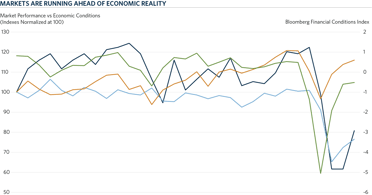
Chart of the Month | Markets are Running Ahead of Economic Reality
When investors open their second quarter investment reports, many will be shocked by the magnitude of stock market gains in the second quarter. Their surprise could be voiced by a rhetorical question...

Balancing Risk and Return
Risk surrounds us, and for investment fiduciaries it is inescapable if meaningful real returns are to be sought. While risk and return constitute the axes upon which investment portfolios are built,...
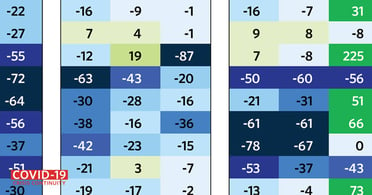
Chart of the Month | Measuring Social Distancing with Mobility Trends
We continue to monitor the level of social distancing as an indicator for business activity and improvement in consumer sentiment. Personal spending experienced the largest month-over-month drop on...
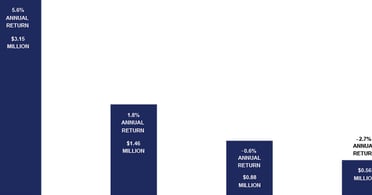
Chart of the Month | The Dangers of Timing a Bear Market
It has been well documented that trying to avoid market downturns by selling out of stocks and moving to cash can be damaging to long-term portfolio values. And while there are strong behavioral...
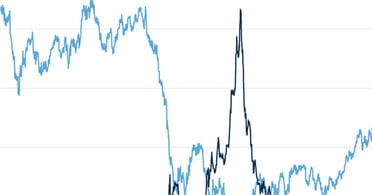
Chart of the Month | A Price War Erupts in the Oil Market
Oil prices declined over 21 percent on March 9, 2020, the largest single-day decline since January 1991 during the Gulf War[1]. There was optimism prior to the OPEC (Organization of Petroleum...

Long-Term Equity Investors: A Global Perspective
Over the past decade U.S. equities have consistently outperformed international markets, leading many investors to question the role of non-U.S. equities in their portfolio. While the current cycle...
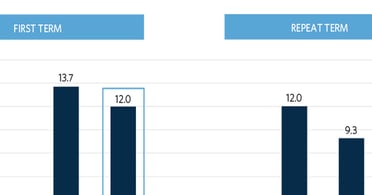
Chart of the Month | Election Year Market Trends
As we enter the 12th year of economic expansion since the Great Financial Crisis, investors continue to wonder whether 2020 will be the year when equity markets finally experience a correction....

Taking a Fresh Look at Spending Models
Investors have limited control over the returns their portfolios generate. They have more control over their spending. That doesn’t make it easy. Compared to some earlier periods, volatility in the...

5 Key Questions When Comparing OCIO Provider Fees
The market for Outsourced Chief Investment Officer (“OCIO”) services has boomed over the last decade. Today, OCIO assets under management are by some estimates nearly $1.5 trillion, 2.5 times the...

A sit-down with Richard Fisher
As a follow-on to the Commonfund Forum 2019 panel discussion, The Global Economy and the Return of Risk, Richard Fisher, former President and CEO of the Federal Reserve Bank of Dallas, further...

The Fallacy of Manager Diversification – How “Horse Races” Can Increase, Not Reduce Risk
On the surface, hiring two (or more) multi-asset managers to manage an entire portfolio may seem like a good idea. Intuitively, it would seem to reduce manager concentration risk, and provide...

How to get Started in Responsible Investing
The biggest challenge in implementing any type of responsible investment program is in clearly defining and prioritizing those issues most relevant to an organization. Although it may seem a...

Identifying an “E” Factor
Over the past year the Commonfund investment teams have undertaken research to identify and isolate a new factor associated with the environmental sustainability of a stock (or a portfolio of...

A Cost-Effective Approach to Hedge Fund Allocations: Part 2
Let’s start with a quick recap of Part 1 of this story, which can be boiled down to three main points: Investors often spend too much for market beta, paying “2 and 20” for hedge funds that deliver...

A Cost-Effective Approach to Hedge Fund Allocations: Part 1
At the risk of beating a dead horse, hedge funds are not an asset class. This is especially true in the way in which Commonfund selects and constructs its hedge fund portfolios: focusing...

Equity Portfolio Construction – Through a Risk Factor Lens
At Commonfund, we aim to build multi-manager, active risk equity portfolios with a clear objective of consistent outperformance versus passive policy benchmarks. Our approach is to take intentional...

How Much Beta is in Your Equity Portfolio?
Leveling the Field in the “Tug of War” Between Active and Passive… Active Equity Manager Universal Objective: Outperform the Passive Alternative It’s undeniable that every active equity manager’s...

Long-Term Trends for Long-Term Investors
Nonprofit institutions have the distinct advantage of having the longest time horizon of any investors – often perpetuity. This affords an opportunity to consider investments based on secular trends...

What do the Cable Television and Hedge Fund Industries Have in Common?
These industries may seem an odd pairing, but both are in the midst of a disruption-led, industry-wide rationalization process. The two industries share in common a historically evolved “bundling”...

Private Credit Opportunities – Direct Lending to U.S. Middle Market Companies
Much has been made of the challenges endowment, foundation and nonprofit investors face in achieving a CPI+ five percent return target. One way to improve the probability of attaining this goal is to...

A False Sense of Diversification?
As we have undergone the process of re-underwriting all of Commonfund’s equity managers and funds over the last 6 months, we have tackled anew the age old question of how many funds does one...

Bridging the Gap: Carbon and Fiduciary Responsibility
Most institutional investor discussions and actions regarding global warming have been at two ends of the spectrum: either divest from fossil fuels entirely or remain fully invested. A better...

Six Key Questions To Ask OCIO Providers
“Outsourced CIO” (or OCIO) is a term that might not be familiar to many. In the past it has been defined as a traditional consulting model in which the process of interviewing potential investment...

Defining Risk For Your Organization
Merriam-Webster’s defines risk as the “possibility of loss or injury.” The financial profession — borrowing from Modern Portfolio Theory — uses the standard deviation of a portfolio’s returns to...

What is ESG Investing?
Generally speaking, Environmental Social and Governance, or ESG for short, is used to describe a group of characteristics that can have a material impact on the long-term success of a company and,...

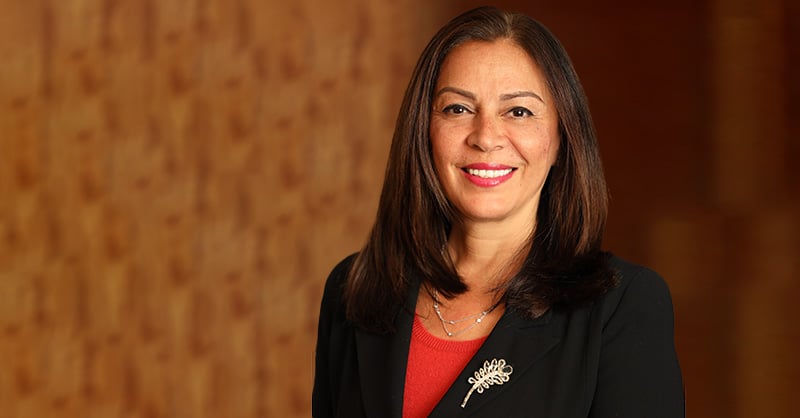
The Housing Market Paradox